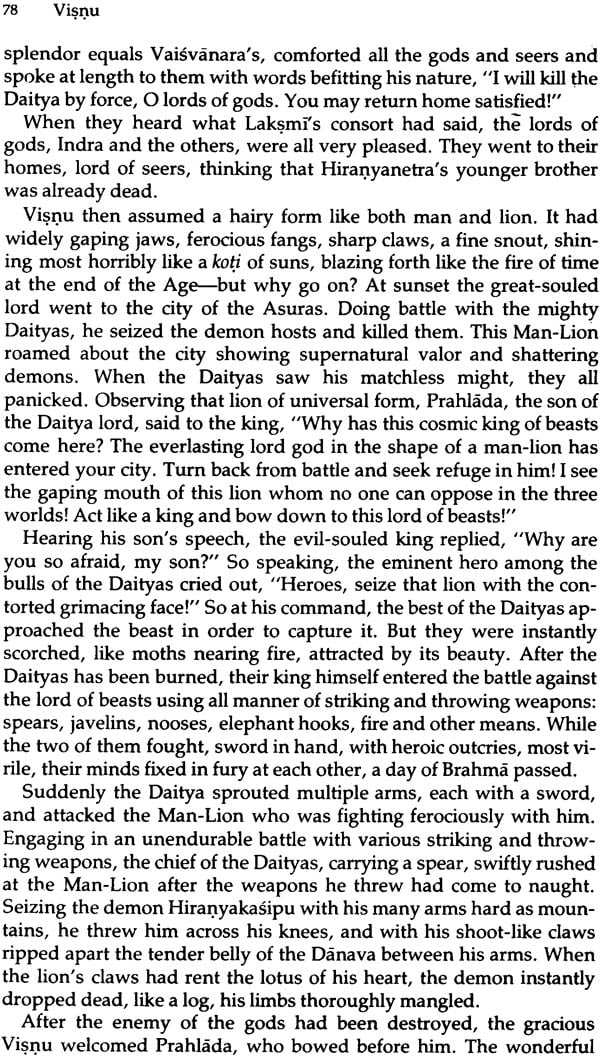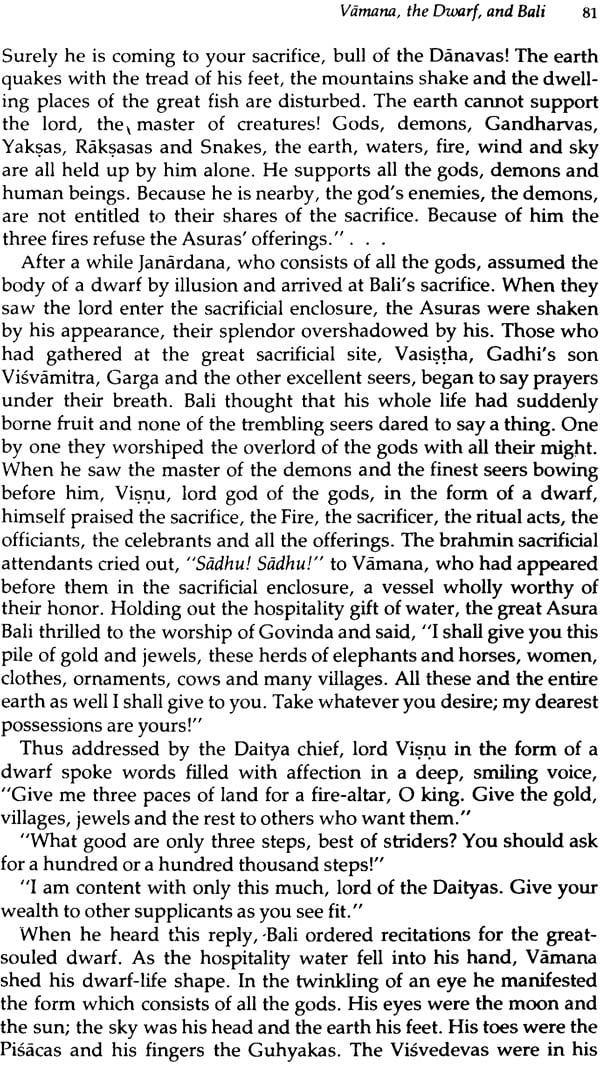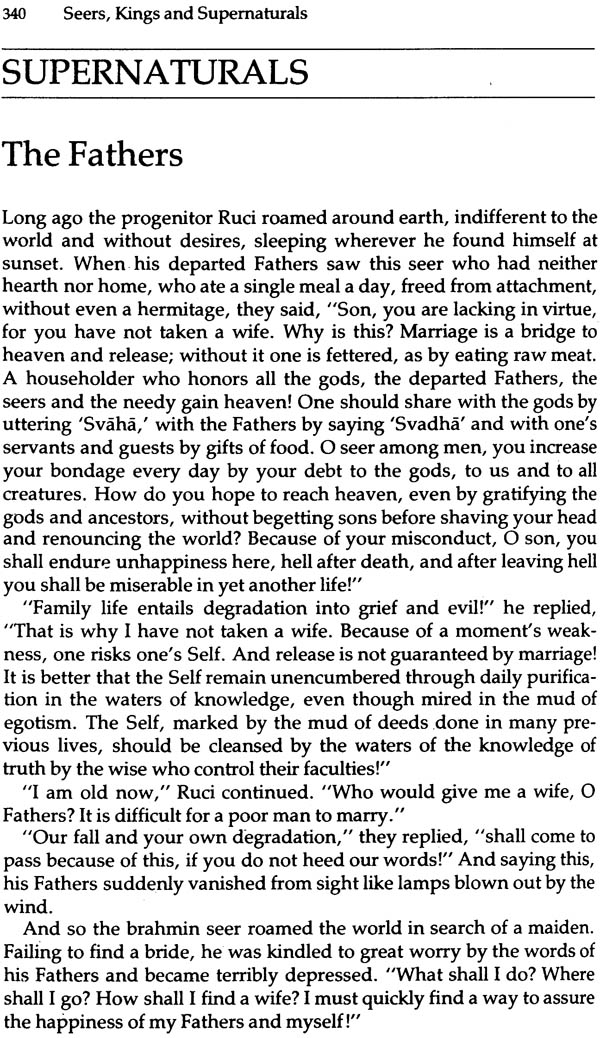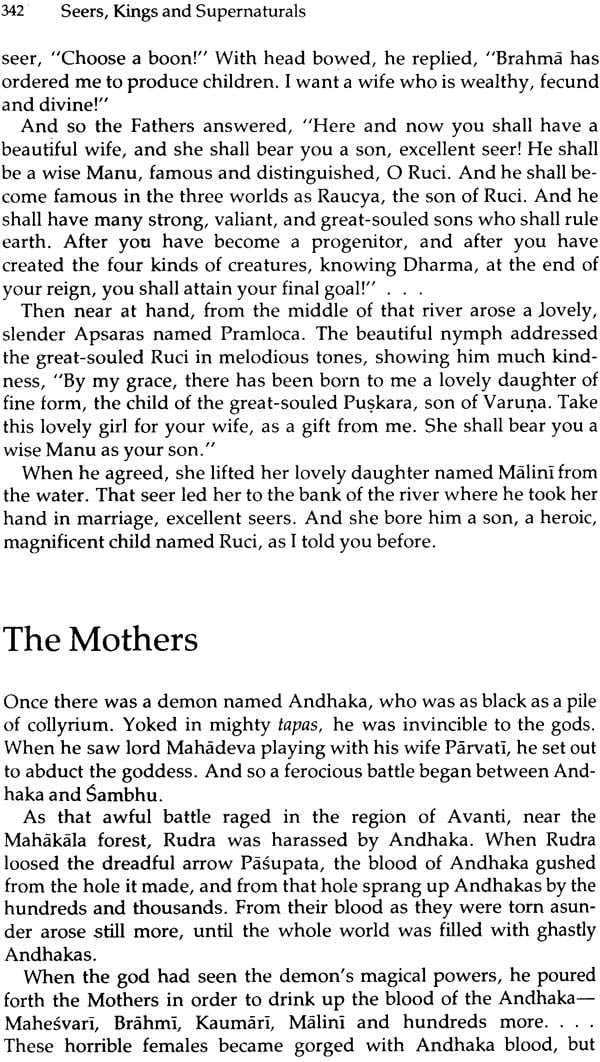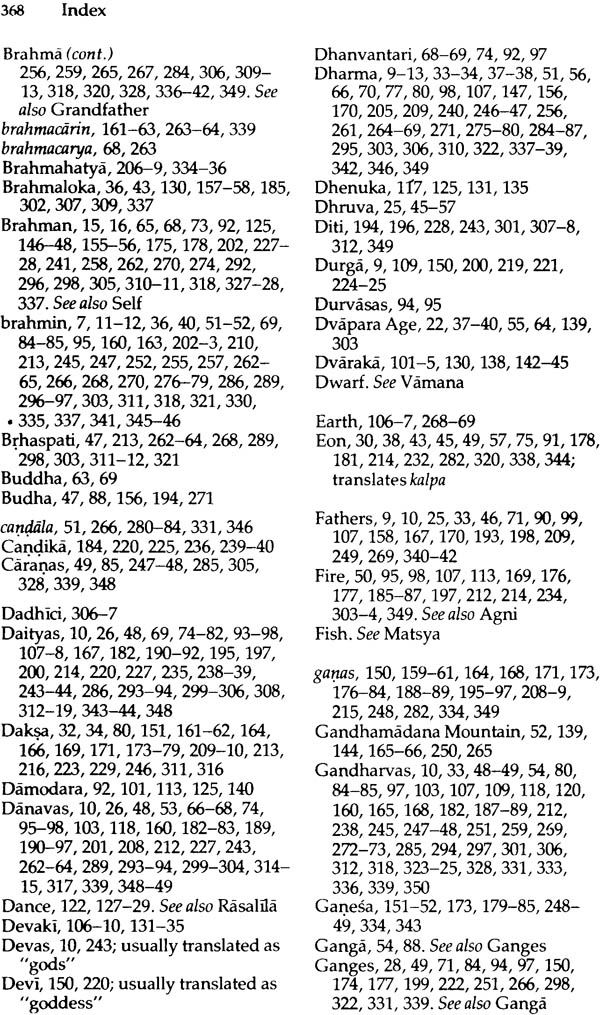
Classical Hindu Mythology: A Reader In The Sanskrit Puranas
Book Specification
| Item Code: | NAD142 |
| Author: | Cornelia Dimmitt &J.A.B. van Buitenen |
| Publisher: | Sri Satguru Publications |
| Edition: | 1998 |
| ISBN: | 8170305969 |
| Pages: | 388 |
| Cover: | Hardcover |
| Other Details | 8.7 inch X 5.7 inch |
| Weight | 570 gm |
Book Description
There has been a clear need since Heinrich Zimmer’s Myths and Symbols in Indian Art and Civilization* for a textbook that would incorporate the classical statements of Hindu mythology, a comprehensive, if not exhaustive, selection of Indian accounts of their own cherished stories. This need has been felt and variously responded to. In recent years R.K.Narayan, in Gods, Demons and others, has given an excellent version of his own beloved lore. James Kirk, also with a southern Indian emphasis, has retold some very fine tales in his stories of the Hindus. In her Hindu Myths, $ Wendy O’Flaherty has dug more ambitiously into Veda, Epic and Purana with an historical perspective on the vagaries of Hindu mythography. In addition, cultural anthropologists have shown more and more interest in the ways little communities relate to a larger network of cultures and even civilizations (“Great Traditions”), but their large knowledge about small societies has often found pause before their unfamiliarity with the larger traditions. The historians of Indian art, on the other hand, have built up an architecture of Hindu mythology so magisterial that it has become almost a closed world to the non-specialist.
The authors felt it might be useful to present those who are in-trigued by the myths of Indian civilization with representative classical texts. We did not expect to find a single origin for Hindu mythology, since sources abound in a veritey of media. The Sanskrit Puranas proved particularly useful for our purpose. If their very multitude suggests that there is no single original text for Hindu myths, their common language confirms that there is a single tongue
*Heinrich Zimmer, Myths and Symbols in Indian Art and Civilization (New York: Pantheon Books,1946)
+R.K.Narayan, Gods, Demons and others (New York:Viking Press, 1964)
+ James A.Kirk, Stories of the Hindu (New York:Macmillan, 1972).
Swendy Doniger O’Flaherty, Hindu Myths (Penguin Books,1975);in her appendices O’Flaherty has assembled an invaluable collection of bibliographical material concerning puranic mythology which we saw no need to duplicate in this volume.
In which their variety was collected. They are not original texts; with every vocative they make clear that they are told by teachers speaking to students who want to listen. And the very substance of this teaching consists of stories about the gods, or mythology, as we understand it.
Of course the Puranas themselves had their teachers too. The influence of the epics, the Mahabharata and the Ramayana, has been profound; and on those teachers, the influence of the Veda is clear, though not always transparent. But we wanted to present the mythology of the Hindu tradition from a period later than the epics, much as it has been received ever since, too often told perhaps, but miraculously still fresh.
Moreover, the authors saw no need to duplicate materials that are already available, or are currently being translated, notably the Mahabharata and the Ramayana.*A Purana reader, besides being justifiable in itself, has the value of presenting texts not readily available to most people. While tradition ascribes to the Mahabharata a lakh of couplets, or one hundred thousand, to the Puranas it assigns a crore, or ten million. There are translations of some of this material. But not of all the eighteen Great Puranas, let alone the Minor Puranas. Thanks to the generosity of the Kashiraj Trust founded by the Markandeya, are also well edited. But it cannot be said that the Puranas are an open book even for the specialist.
The sheer mass of the materials imposed limitations on us. We has no intention of reproducing the contents of any single Purana, because each one includes, in a addition to mythology, a wealth of didactic, legal and moralistic material. In fact, their encyclopedic aspirations cover the breath of human knowledge for their place and time. In making our selections, we have used the Puranas most popular in the Hindu tradition itself; our chief sources have been the Visnu, Markandeya, Bhagavata, Matsya, Vamana and Kurma, and to a lesser extent the Brahmavaivarta, Siva and Garuda. With such an abundance of riches to choose from, the choice on occasion became simply a matter of balance. We could have used the Bhagavata more extensively on Krsna, for example, but since that text has been translated and anthologized often, the Visnu and Brahmavaivarta accounts seemed preferable.
We intend this book as a reader. Hence we have felt our responsibility to its readers quite strongly. Even though tempted, we have tried not to interpose a private interpretation between the text and its users. The introductions before each section seek mostly to describe and give guidance to the reader, whom oratorically, we presume to know very little. We hope to be forgiven for stating the obvious.
There are some cautions. Some of the Sanskrit text editions used are quite good; some are very poor. While we have attempted to render our texts accurately, there were times when the texts failed us, and emendation was necessary. The specialist will readily discern the course we have chosen. At the beginning of certain selections we have sometimes extended the sense of the text in the translation, to facilitate transitions between fragments. And although pleading the exigencies of space is poor justice, at time we have shortened stories because the alternative was to select a shorter but poorer version; the couplets omitted are indicated in the Notes on Sources. Contrariwise, we have not stinted on the variety of names attributed to a single deity, for identities in which each one is clothed. A glossary of names will, we hope, assist the reader.
While both authors stand behind the whole book, the reader needs to know the division of labor between them. The initiative for the book was taken by Cornelia Dimmitt, who located and selected the texts, and who is largely responsible for the content of the introductions. The translation itself has been wholly collaborative.
-
The Mahapuranas embody the received tradition of Hindu mythology. This anthology contains fresh translations of these myths, only a few of which have ever been available in English before, thus providing a rich new portion of Hindu mythology.
The book is organized into six chapter.”Origins” contains myths relating to creation, time and space. ”seers, kings and Supernafurals” relates tales of rivers, trees, animals, demons, and men, particularly heroes and sages. Myths about the chief gods are dealt with in three separate chapters: “Krsna,” ”Visnu,” and Siva.”the chapter “the Goddess”presents stories of the wives and lovers of the gods, as well as of kali, the savage battle goddess.
In their introductions, the editors provide a historical setting in which to discuss Hindu mythology as well as a full analysis of its basic sources. The many names given the gods and goddess in the Sanskrit texts have been retained since their multiplicity is an essential part of the richness of the original. The editors have provided a thorough glossary to make these names accessible.
CORNELIA DIMITT is Assistant Professor of Theology at Georgetown University and a Core Faculty Member of the Washington, D.C. Consortium Program in History of Religions.
| Preface | xiii | |
| The Puranas :An Introduction | 3 | |
| 1. Origins | Introduction | |
| The origin of Brahma from the Lotus in Visnu’s navel | 30 | |
| Prakrti and Purusa | 31 | |
| The Cosmic Egg | 32 | |
| The Origin of the World from Brahma | 32 | |
| The Four Heads of Brahma | 34 | |
| Purusa, the Cosmic Person | 35 | |
| The Origin and Nature of Time | 36 | |
| The Four Ages | 38 | |
| The Kali Age | 41 | |
| The Dissolution of the World in Visnu | 41 | |
| The Dissolution into Prakrti and Purusa | 43 | |
| The Shape of Space | 45 | |
| The Seven Heavens | 46 | |
| The Seven Netherworlds | 48 | |
| The Hells | 49 | |
| The Regions of Earth | 52 | |
| The Origin of the Seers and the Manus | 55 | |
| The Manvantaras | 57 | |
| 2. Visnu | Introduction | |
| The Four Forms of Visnu | 66 | |
| The Twelve Avataras of Visnu | 67 | |
| The Twenty-Two Avataras of Visnu | 68 | |
| The Avataras of Visnu and the Story of Anasuya | 69 | |
| Matsya, the Fish | 71 | |
| Kurma, the Tortoise | 74 | |
| Varaha, the Boar | 75 | |
| Narasimha, the Man-Lion | 76 | |
| Aditi and the Birth of Vamana, the Dwarf | 79 | |
| Vamana, the Dwarf, and Bali | 80 | |
| Parasurman, Rama with the Axe | 82 | |
| Rama in the Ramayana | 85 | |
| Krsna in the Mahabharata | 88 | |
| Vaikuntha, Visnu’s Celestial City | 90 | |
| Sudarsana, Visnu’s Discus | 91 | |
| Bali and Sudarsana, the Discus | 93 | |
| The Churning of the Ocean | 94 | |
| Visnu and Sri | 98 | |
| 3. Krsna | Introduction | |
| Childhood | ||
| The Conception of Krsna | 106 | |
| The Birth of Krsna | 109 | |
| Putana, the Child Killer | 111 | |
| The Naughty Children Rama and Krsna; the Move to Vrndavana | 112 | |
| Kaliya, the Snake | 114 | |
| Mount Govardhana | 116 | |
| Conversation with the Cowherds | 117 | |
| Youth | ||
| Krsna and Radha | 118 | |
| The Theft of the Clothes | 122 | |
| The Rasalila Dance | 124 | |
| Radha and the Dance | 127 | |
| The Departure of Krsna | 130 | |
| Kamsa | ||
| The plotting of Kamsa | 131 | |
| The invitation to Rama and krsna | 132 | |
| The Hunchbacked Girl | 133 | |
| The Death of Kamsa | 134 | |
| Adulthood | ||
| The Building of Dvaraka | 138 | |
| The Longing of the Cowherd Women for Krsna | 139 | |
| The Abduction of Rukmini | 140 | |
| Pradyumna and the Fish | 141 | |
| The End of the Yadavas | 142 | |
| 4. Siva | Introduction | |
| The Origin of Rudra, the Howler | 155 | |
| The Birth of Parvati | 157 | |
| The Test of Parvati’s Tapas | 161 | |
| The Betrothal of Siva and Parvati | 164 | |
| The Wedding of Siva and Parvati | 167 | |
| Daksa’s Insult | 171 | |
| The Destruction o Daksa’s Sacrifice | 174 | |
| Ganesa | 179 | |
| Karttikeya | 185 | |
| Sukra | 188 | |
| The Burning of Tripura | 189 | |
| Sunartaka the Dancer | 198 | |
| The Tandava Dance of Siva | 200 | |
| The Dance of Siva in the Sky | 202 | |
| The sages of the Pine Forest | 203 | |
| Brahma, Visnu and the Linga of Siva | 205 | |
| The Skull –Bearer | 206 | |
| Kamadeva, the God of Love | 209 | |
| The Illusions of Siva | 212 | |
| The Weapons of Siva | 213 | |
| The Origin of Women | 215 | |
| Hari- Hari | 216 | |
| 5. The Goddess | Introduction | |
| The Blazing Tower of Splendor | 227 | |
| Siva and Sakti; the Great Goddess | 229 | |
| The Demons Madhu and Kaitabha | 232 | |
| The Origin of the Goddess from the Gods | 233 | |
| The Death of Mahisa, the Buffalo Demon | 237 | |
| The Birth of Kali and the Final Battel | 238 | |
| Bhadrakali and the Thieves | 240 | |
| Sarasvati and King Navaratha | 241 | |
| 6. Seers,Kings And Supernaturals | Introduction | |
| Seers | ||
| Markandeya and the Cosmic Ocean | 253 | |
| Narada | 256 | |
| Kandu | 258 | |
| Sukra and Kaca | 262 | |
| Agastya and Vasistha | 265 | |
| Vasistha and Visvamitra | 30 | |
| Kings | ||
| Prthu and the Milking of the Earth | 268 | |
| IIa and Sudyumna | 269 | |
| Pururavas and Urvasi | 271 | |
| Hariscandra and His Son | 273 | |
| Hariscandra and Visvamitra | 274 | |
| Pariksit | 286 | |
| Yayati | 288 | |
| Viduratha | 292 | |
| Saubhari | 295 | |
| Sakuntala | 297 | |
| Vedic Gods and Demons | ||
| The Mandehas at Twilight | 298 | |
| The Battle between the Gods and Demons | 299 | |
| Indra and Vrtra | 303 | |
| Dadhici’s Bones | 306 | |
| Diti and the Maruts | 307 | |
| The Seers’s Wives and the Maruts | 308 | |
| Soma | 310 | |
| Prahlada and Hiranyakasipu | 312 | |
| Indra and the Ants | 320 | |
| Rivers and Sacred Fords | ||
| The Descent of the Ganges River | 322 | |
| The Hermitage of Atri | 323 | |
| The River Sarasvati and Kuruksetra | 327 | |
| The River Yamuna | 329 | |
| The Virtues of Varanasi | 330 | |
| Varanasi and the Yaksa | 331 | |
| The Pilgrimage of Siva to Varanasi | 334 | |
| Gaya | 336 | |
| Prayaga | 337 | |
| Supernaturals | ||
| The Fathers | 340 | |
| The Mothers | 342 | |
| Garuda | 345 | |
| Denizens of the Netherworlds | 347 | |
| Glossary | 351 | |
| Notes on Sources | 361 | |
| Bibliography of Sanskrit Puranas | 365 | |
| Index | 367 |




